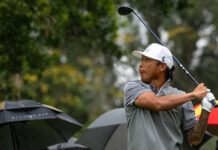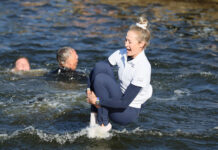
It is officially Masters week! As everyone already knows, Augusta National is one of the most beautiful courses that the Tour plays. The course sets up as a Par-72 that plays 7,435 yards from the Championship tees.
To get the memorable week started, let’s take a look at each hole and how it is set up.
This post originally ran April 4, 2017.
HOLE 1 – TEA OLIVE
Par-4 | 445 yards
The Augusta National Skinny
The first is a slight dogleg right that plays uphill. Drives to the left may catch the trees. The hole requires a precise second shot to an undulating green. A poorly struck approach may result in a difficult two-putt.
In 1935, the hole featured a left fairway bunker that was later removed. A greenside bunker, front and left, was added in 1951.
Low Year: 4.008 (1974)
High Year: 4.474 (2007)
Historical Average: 4.24 (6)
HOLE 2 – PINK DOGWOOD
Par-5 | 585 yards *
The Augusta National Skinny
No. 2 is a dogleg left which may be reachable in two. Large, deep greenside bunkers demand special attention on the second shot.
Originally, the green was guarded by a lone bunker on the right. That bunker was reduced in size in 1966, and a left bunker was added in 1946.
Low Year: 4.467 (2020)
High Year: 4.996 (1957)
Historical Average: 4.78 (16)
HOLE 3 – FLOWERING PEACH
Par-4 | 350 yards
The Augusta National Skinny
A classic short par four. Golfers attempt to hit short of the four fairway bunkers, resulting in a full shot to the green, where it is better to be long than short. The putting surface slopes right to left, with a thin neck on the left side guarded by a bunker.
Alister MacKenzie, the architect of Augusta National with Bobby Jones, believed the third hole to be nearly perfect in design. Thus, this hole has been changed less than any other on the course.
Low Year: 3.885 (2011)
High Year: 4.267 (1989)
Historical Average: 4.08 (14)
HOLE 4 – FLOWERING CRAB APPLE
Par-3 | 240 yards
The Augusta National Skinny
This hole is a stout par three that requires a long iron and is often made harder by deceptive winds. Two bunkers, front right and front left, guard the green, which slopes back to the front.
The green was originally shaped like a boomerang. It’s now a bit wider, the bend slightly less extreme. But the hole remains an elusive target.
Low Year: 3.089 (2020)
High Year: 3.497 (1956)
Historical Average: 3.28 (3)
HOLE 5 – MAGNOLIA
Par-4 | 495 yards *
The Augusta National Skinny
An uphill, dogleg left to a sloping green. The fairway bunkers are deep and positioned to demand accuracy off the tee. To clear them requires a carry of 315 yards. The green slopes back to the front, and a rear bunker catches balls hit too long.
This hole was inspired by the legendary Road Hole at the Old Course at St. Andrews. Bobby Jones initially disapproved of the fairway bunkers.
Low Year: 4.061 (2001)
High Year: 4.475 (1956)
Historical Average: 4.26 (5)
HOLE 6 – JUNIPER
Par-3 | 180 yards
The Augusta National Skinny
This par three features an elevated tee and a large undulating green. The shifting levels of the putting surface from front to back make the pin position very important.
In the 1930s, the green was fronted by a stream, and in the 1950s by a pond. But the hazard rarely came into play and was therefore removed in 1959.
Low Year: 2.984 (1974)
High Year: 3.269 (1946)
Historical Average: 3.14 (13)
HOLE 7 – PAMPAS
Par-4 | 450 yards
The Augusta National Skinny
The drive on this tight hole is often played to the left-center of the fairway to set up a second shot from a level lie. From there, a short to mid-iron may be played, but it is important to avoid the three bunkers in front of the green and the two behind.
The seventh hole lacked character until Horton Smith, the 1934 and 1936 Masters champion, suggested that the green be rebuilt and that bunkers be added.
Low Year: 3.986 (2001)
High Year: 3.269 (1972)
Historical Average: 4.16 (10)
HOLE 8 – YELLOW JASMINE
Par-5 | 570 yards
The Augusta National Skinny
An accurate drive is needed to avoid the fairway bunker on the right side on this uphill hole. The long, narrow green is bunkerless. It is guarded instead by a series of mounds, the biggest of which line its left side.
The distinctive greenside mounds were removed in 1956 to improve sight lines for spectators, but were restored in 1979 under the supervision of Byron Nelson. Bruce Devlin scored the second double eagle in Masters history here in 1967.
Low Year: 4.628 (2019)
High Year: 4.991 (1956)
Historical Average: 4.82 (15)
HOLE 9 – CAROLINA CHERRY
Par-4 | 460 yards
The Augusta National Skinny
This hole is best known for its green that slopes from back to front. Players often drive down the right side to avoid having to contend with two left greenside bunkers on their second shots.
The original ninth green had a more extreme “false front” than the current green has. Shots landing there invariably rolled back down the fairway.
Low Year: 3.967 (2020)
High Year: 4.401 (1955)
Historical Average: 4.14 (12)
HOLE 10 – CAMELLIA
Par-4 | 495 yards
The Augusta National Skinny
This long par four plays steeply downhill and features a nearly 60-yard-long center bunker well short of the green. Players will try to drive the ball to the left center for the best angle into a green that pitches right to left. Until 1935, this was the first hole. It is traditionally the most difficult hole on the course.
Originally, the 10th green was positioned to the right of the huge fairway bunker. In 1937, the putting surface was moved to the rise beyond the bunker, making the hole extremely demanding.
Low Year: 4.121 (2018)
High Year: 4.691 (1956)
Historical Average: 4.30 (1)
HOLE 11 – WHITE DOGWOOD
Par-4 | 520 yards *
The Augusta National Skinny
At this hole begins Amen Corner, and wind is often a factor. The tee shot plays downhill and left to right. A pond guards the green to the left and a bunker is strategically placed right center. This hole may best be remembered for Larry Mize’s miraculous chip-in to defeat Greg Norman in a playoff in the 1987 Masters.
Prior to 1950, Rae’s Creek ran in front of this green. It was replaced by a larger hazard in form of the current pond.
Low Year: 4.061 (1995)
High Year: 4.644 (1956)
Historical Average: 4.30 (2)
HOLE 12 – GOLDEN BELL
Par-3 | 155 yards
The Augusta National Skinny
One of the world’s most famous golf holes, this is Augusta National’s shortest par three. Club selection is often difficult, as varying winds can require anything from a six-iron to a nine-iron for Masters competitors. The daunting presence of Rae’s Creek and three strategically placed bunkers make it imperative that players land their shots on the putting surface. Golfers walk across the Ben Hogan Bridge to reach the green.
The 12th hole has been a heart-breaker from the start. Its fickle winds, narrow green and looming water have thwarted many runs for the Masters title.
Low Year: 3.030 (2002)
High Year: 4.556 (1966)
Historical Average: 3.28 (4)
Hole 13 – AZALEA
Par-5 | 545 yards *
The Augusta National Skinny
An accurate tee shot to the center of the fairway on this sweeping dogleg left allows a player to go for the green in two. A tributary to Rae’s Creek winds in front of the raised green, and four bunkers threaten behind. The Byron Nelson Bridge is located just off the tee.
More discovered than designed, this hole was originally an open field. Virtually all that Alister MacKenzie had to do was to build a green on the far side of the stream.
Low Year: 4.474 (2019)
High Year: 5.042 (1976)
Historical Average: 4.77 (18)
HOLE 14 – CHINESE FIR
Par-4 |440 yards
The Augusta National Skinny
The primary defense on this bunkerless par four is a terraced putting surface that drops significantly from left to right. Following a well-placed drive, the second shot will usually be a middle iron.
A fairway bunker that once sat to the right of the landing area was removed after the 1952 Masters, making this the only hole at Augusta National that does not have a single bunker.
Low Year: 3.9396 (2011)
High Year: 4.413 (1949)
Historical Average: 4.17 (8)
HOLE 15 – FIRETHORN
Par-5 | 550 yards *
The Augusta National Skinny
A famously reachable par five when the winds are favorable. A well-struck second shot must be played over the pond and away from the bunker that guards the green on the right. Gene Sarazen hit his “shot heard ’round the world” here when he holed a four-wood approach from 235 yards away for a double eagle in 1935.
In 1935, the 15th green had no greenside bunker. Bobby Jones firmly believed that all par fives on the course should be within reach of two shots by better players.
Low Year: 4.505 (1991)
High Year: 5.097 (1998)
Historical Average: 4.78 (18)
HOLE 16 – REDBUD
Par-3 | 170 yards
The Augusta National Skinny
This hole is played entirely over water to a green secured by three bunkers. With the putting surface significantly pitched from right to left, an exacting tee shot is required to set up a reasonable birdie chance.
Alister MacKenzie’s original 16th hole resembled the 12th, but it proved too easy for Masters competitors. In 1947 a pond was built and the green was moved right.
Low Year: 2.875 (2020)
High Year: 3.422 (1950)
Historical Average: 3.14 (11)
HOLE 17 – NANDINA
Par-4 | 440 yards
The Augusta National Skinny
The putting surface at this uphill par four offers its share of challenges, as it seems to slope off in all directions. The back-right hole location is particularly demanding.
The original 17th green, undefended by bunkers, was designed to accept run-up shots. Now, front bunkers make lofted approaches a safer bet. The Eisenhower Tree loblolly pine named after the 34th president because he hit into it so often that he requested it be torn down once stood just left of the fairway, 210 yards from the tee. A February 2014 ice storm caused irreparable damage to most of the tree’s major limbs, resulting in its removal.
Low Year: 3.949 (1996)
High Year: 4.348 (1951)
Historical Average: 4.16 (9)
HOLE 18 – HOLLY
Par-4 | 465 yards
The Augusta National Skinny
One of the most famous finishing holes in golf, this uphill dogleg right is protected by two bunkers at the left elbow of the fairway. A drive hit down the center will often require a middle iron for a second shot to a deep, narrow green guarded by one bunker short-left and another hard right.
Even in its original form, the 18th green had two distinct tiers. The surrounds have been contoured to improve sight lines for spectators.
Low Year: 4.014 (2001)
High Year: 4.461 (1954)
Historical Average: 4.23 (7)
Credit: Masters.com






































